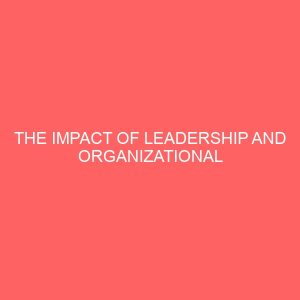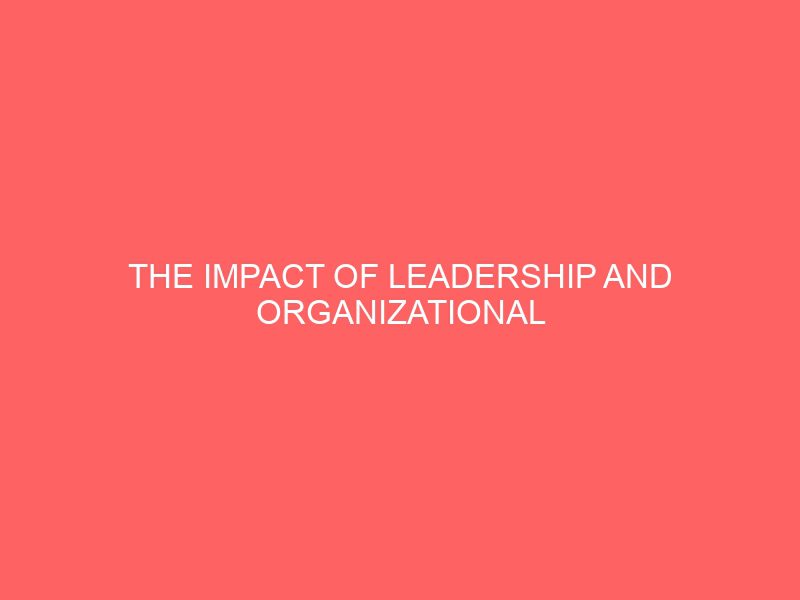THE IMPACT OF LEADERSHIP AND ORGANIZATIONAL BEHAVIOUR ON EMPLOYEES PRODUCTIVITY
ABSTRACT
In modern society, economic prosperity and progress depend largely on the quality of leadership. This is true of nation states as it is of individuals or generate among policy makers, corporate executives and investors are largely justified. Leadership is very essential in an organization because achievements and results occur corollary to the traits being projected by the leader. The major aim of every organization is to grow. The relationship between the management and employees has a great impact to that effect. Employees will be expecting to earn higher so as to sustain their living while the management will be expecting employee to work had so as to see that the objectives of the organization is realized. Organizational behaviour is more or less a pure psychology attached to the institutional companies and applicable to achieve organisational goals. It constitutes the activities of an organisation that can be observed by another organisation or by experimental instruments. The research work will focus on the leadership and effects of leadership style, appraisal and organisational behaviour of management and employees. The work is made up of five chapters. In the first chapter we will discuss about the general ideas of leadership, organisational behaviour and its effects on management and employee. In the second chapter we shall look into the literature review, we shall look into various authors who have researched on the leadership styles, appraisal and organisational behaviour of management and employees. In chapter three, we will present research methodology while chapter four will be presentation of data analysis. We shall also interpret the data and test the hypothesis and finally, chapter five will be summaries, findings and recommendation
CHAPTER ONE
1.1 INTRODUCTION
GENERAL IDEA OF LEADERSHIP
Leadership is a process in which a leader attempts to influence his or her followers to establish and accomplish a goal or goals.
LEADERSHIP
The capacity to lead others: command, lead.
An act or instance of guiding: direction, guidance, lead, management. See affect/ineffectiveness.
Leadership is the process through which an individual tries to influence another individual or a group of individuals to accomplish a goal. Leadership is valued in our culture, especially when it helps to achieve goals that are beneficial to the population, such as the enactment of effective preventive health policies. An individual with leadership qualities can also improve an organization and the individuals in it, whether it be a teacher who works to get better teaching materials and after school programs or an employee who develops new ideas and products and influences others to invest in them.
Leadership can be exhibited in a variety of ways and circumstances. Mothers and fathers show leadership in raising their children with good values andencouraging them to develop to their potential. Teachers show it in inspiring students to learn and to develop their intellectual capacity. Health care workers can be leaders and develop services that meet the needs of the communities they serve, or work in collaboration with other organizations to create cost effective, prevention oriented programs and services.
1.2 BRIEF HISTORY OF access BANK PLC
access Bank Plc began as a private limited liability company on March 21, 1991 the company was incorporated on December 20, 1990. Ten years later, in February 2001, it became a universal bank. In January 2005, following a highly successful Private Placement share offer which substantially raised the Banks equity base, access Bank became a public limited company. In May 2005, the Bank was listed on The Nigerian Stock Exchange. Moreover, in January 2008, access Banks Global Depositary Receipts GDR was listed on the Professional Securities Market of the London Stock Exchange. The first bank in Africa to record that feat.
1.3 STATEMENT OF THE PROBLEM AND SUB PROBLEM
The design of the investigation is to elicit the effect of the different leadership styles in finance oriented and services oriented organization in order to determine its distinct impact on the organizational behaviour of management and employees in the case organization.
SUB PROBLEM I: The purpose of the study is to evaluate the factors of leadership the traits: intelligence, initiative, imagination, communication, the skills, analytical, diagnostic, conceptual, the status, recognition and the situation culture in the case organisation with the view to calculate their contribution in attaining organisational objective. Contribution to efficiency and growth in profit.
SUB PROBLEM II: The object on the inquiry is to ascertain the most favourable leadership style amongst autocratic, democratic, paternalistic, and laissez faire, used in the case organisation to determine its influence on management and employees.
1.4 RESEARCH PROBLEM ORIENTED HYPOTHESIS
In aiming to go on with the stated problem of study, the following research problem oriented hypotheses are revealed.
HYPOTHSIS I: Leadership style that display intelligence, initiative and communication traits, analytical, diagnostic and conceptual skills, recognition and situation, contributes certainly to attaining organisational efficiency and growth in point.
HYPOTHESIS II: The leadership style that has no monopoly of authority improves interpersonal relationship that employee oriented determines positive reaction in form of contribution to decision making, punctuality and work to achieve company goals.
1.5 OBJECTIVE OF THE STUDY
Research is basically aimed at determining ones view of related studies at every time.
In the course of studying the aforementioned subject on the leadership style: one will be able to determine those areas where the different types of leadership styles have contributed immensely to organisation goals.
For the purpose of this study, the behaviour of the management and employees can be viewed as endogenous as well as exogenous. The researcher will therefore proceed to express and state those objectives which the study is expected to accomplish. They are as follows:
a. The value of the different factor of leadership the leaders traits, skills and subordinates reaction, status, recognition and the prevailing situation in finance oriented as well as service oriented organisation.
b. To critically evaluate the nature of leadership in affecting work performance
c. To determine the effect of leadership style and their basic relationship with organisational behaviour
1.6 SIGNIFICANCE OF THE STUDY
The significance of this study is basically a definite scope which will help elicit all the problems and effect of different leadership styles. Also, it will assist in highlighting how management and employees react under stereotyped condition.
In addition, all the aforementioned and determined effects, problems and solutions will be critically viewed to serve as possible recommendations to todays manager who may be willing to employ a particular leadership style.
1.7 LIMITATIONS OF THE STUDY
In pursing this investigation and study, lots of impediments and obstruction were encountered as the research progressed. All these impediments brought about a conspicuous clause with the research work. They include, lack of relevant data due to poor respondent, time constraint and financial conditions.
Lack of relevant data: The design of the study was negatively affected by the nature of respondent, which was projected by the workers within the case organisation. The non challant attitude of most employees approached, sample of the studying population was discouraging relevant information needed for the research was not made available easily to the researcher while the available information were censored before being allowed to be used.
Original price was: ₦3,200.00.₦3,000.00Current price is: ₦3,000.00.








Reviews
There are no reviews yet.